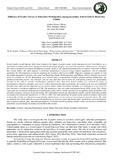| dc.contributor.author | Sifuna, Andrew Barasa | |
| dc.contributor.author | Otieno, Kenneth | |
| dc.contributor.author | Ouda, James Bill | |
| dc.date.accessioned | 2023-11-14T05:52:08Z | |
| dc.date.available | 2023-11-14T05:52:08Z | |
| dc.date.issued | 2023-10-14 | |
| dc.identifier.uri | https://doi.org/10.51867/scimundi.3.1.6 | |
| dc.identifier.uri | http://sciencemundi.net/ojs/index.php/scimundi/article/view/22 | |
| dc.identifier.uri | http://ir-library.mmust.ac.ke:8080/xmlui/handle/123456789/2390 | |
| dc.description.abstract | Several studies in sub-Saharan Africa have looked at the impact of gender norms on the education of girls. Nevertheless, on anationallevel,limitedstudieshaveattemptedtodirectlyinvestigatethegirls’viewsandtheirexperiencesofthesenorms.Therefore,thisstudyisintendedtoinvestigatetheinfluenceofgendernormsontheeducationparticipationofsecondaryschoolgirlsinHomaBay County (HBC). The study adopted a concurrent transformative research design, majorly quantitative with an embeddedqualitative bit. The population of interest comprised all secondary school girls in HBC. Purposive sampling was applied to limitthe sample population to the three sub-counties of Rachwonyo South, Rachwonyo East, and Ndhiwa. Solvin’s formula was used toarrive at a sample size of 393. Respondents were selected using a proportionate stratified sampling method. Additionally, oneguidance/counselling teacher, one principal, and one area education director from the participating schools were purposefullyincludedinthestudytoprovidecomplementaryqualitativedata.Datafromfemalestudentswascollectedbymeansofquestionnaires. Interview schedules were used to collect data from the other participants. The validity of the test was establishedthrough expert input and the adaptation of tests used in similar studies. Instrument reliability was confirmed by a test-retest testthat returned a correlation coefficient of 0.766. The quantitative data was coded and analysed using SPSS version 24.0. Linearregression was run between education participation and gender norms, and the outcome was an equation model. Qualitative dataprovided evaluative references in the discussion. The relationship between the independent variables and the dependent variablewas found to be statistically significant (t = 1.295, p <.001). The study found that the gender norms of most secondary school girlsin Homa Bay County are disposed to unquestioning submissiveness to men and over-involvement in domestic chores. The studyrecommendsthatschoolauthoritiesuseparentalgatheringstocreateawarenessthatfocusesgirls’attentiononcareerdevelopment.Interventions to improve girls’ education participation will benefit from these findings. Similar studies are needed to establish theplausibilityofgeneralizingthefindingsbeyondHomaBayCounty | en_US |
| dc.language.iso | en | en_US |
| dc.publisher | Science Mundi | en_US |
| dc.subject | Influence, Gender, Norms , Education, Participation, Secondary, School, Girls | en_US |
| dc.title | Influence of Gender Norms on Education Participation among Secondary School Girls in Homa Bay County | en_US |
| dc.type | Article | en_US |

